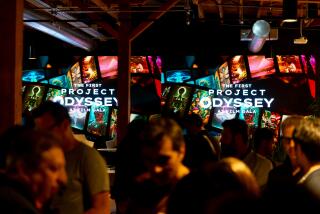Director Bobby Boermans hopes you keep phone on for new film ‘App’
- Share via
Filmmakers cringe when audiences use their cellphones while watching movies. But not Dutch filmmaker Bobby Boermans. In fact, he encourages it.
At least that’s the case for his new film, “App,” which uses a second-screen technology to synchronize a smartphone with a movie or TV screen. Just before “App” begins, viewers can download an app that allows them to see extra footage, text messages, graphics and other material. For optimum viewing, phones should be left on the viewer’s lap, and they will vibrate every time extra content is available.
The thriller arrives on VOD and streaming services on Friday and at the Arena Cinema in Hollywood on Monday for a three-day engagement. The story revolves around a young woman who, after a night of partying, wakes up to discover that a mysterious new app has been downloaded on her smartphone. Iris — Siri spelled backward — initially seems like a bright assistant but quickly turns into a malevolent force.
“App” is the second feature for Boermans. Three years ago, the award-winning director of music videos and commercials made his first film, “Claustrofobia.” Then he and his producer began brainstorming their next project.
“We knew we wanted to do something for a young audience,” said Boermans, 32, from his home in Amsterdam. “The audiences, especially younger kids these days, all have their phones inside the theater. And we came up with the idea of wouldn’t it be cool if the phone sort of attacks you? Why don’t we try to incorporate the phone into the story?”
During their research, they came across the company Civolution, which had developed a digital audio watermarking technology originally used to prevent illegal downloads. The technology had also been used to provide second-screen content in conjunction with TV and Blu-ray viewing and other screenings, but Boermans said “App” is the first new movie to incorporate such content.
At about 30 moments in the film, audiences are signaled to watch their smartphones (though tablets can also be used, phones make for the optimal experience). “I think it’s almost every five minutes,” he said. “We tried to decide what would be the right moment.”
“App” material had to be timed perfectly because, he said, “it takes three seconds each time your eyes shift from the big screen to the small screen to the big screen. So with certain sequences in the film, we had to make them longer so your eyes had time to adjust and you weren’t missing out in anything essential.”
Boermans acknowledged that when the film opened a year ago in the Netherlands, there was some confusion among an older generation of moviegoers, whom Boermans defined as ages 25 to 36. They had a difficult time understanding the concept.
“Whereas the young kids thought it was awesome,” Boermans said. “You could see most of the box office came from young kids.”
Still, Boermans discovered, “App” became a fun social experiment for movie audiences.
“A lot of people were hesitant at first, but then this weird social experiment happened where people started enjoying it,” he said. “They were sort of talking to each other about it, laughing and enjoying the experience.”
The second screen doesn’t work for all kinds of movies, he said, but it can add to the suspense and adventure of science fiction and action thrillers.
Boermans, the son of a director and a producer, was about 13 when he began small jobs on movie sets. “I worked my way up,” he said, and by 15 he was directing music videos. Boermans eventually studied editing at a Dutch film academy and directing for three years at the American Film Institute in Los Angeles.
He recently directed six episodes of an upcoming Dutch TV series that he describes as “‘Damages’ meets ‘Desperate Housewives.’” But he’s eager to come back to Los Angeles.
“Based on ‘App,’ I now have an agent and manager and they send me scripts,” Boermans said, adding later: “I have enough offers to direct movies for the next six or seven years, but I’d rather go to the U.S. and shoot a movie over there. I am now at the crossroads where I must decide.”
More to Read
Only good movies
Get the Indie Focus newsletter, Mark Olsen's weekly guide to the world of cinema.
You may occasionally receive promotional content from the Los Angeles Times.











